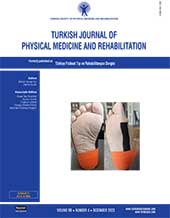Comparing the effectiveness of flexi-bar and stability exercises on postural control in chronic nonspecific low back pain: A randomized controlled study
2 Department of Physiotherapy, Faculty of Rehabilitation Sciences, Shahid Beheshti University of Medical Sciences, Tehran, Iran
3 Department of Biomedical Engineering, Amir Kabir University of Technology, Tehran, Iran
4 Proteomics Research Center, Department of Biostatistics, School of Allied Medical Sciences, Shahid Beheshti University of Medical Sciences, Tehran, Iran DOI : 10.5606/tftrd.2023.10726 Objectives: This study aimed to compare the effect of flexi-bar and stabilization exercises on static and dynamic postural control in patients with chronic nonspecific low back pain.
Patients and methods: In this randomized controlled study conducted between November 2019 and March 2020, 38 patients (19 males, 19 females; mean age: 33.8±6.2 years; range, 20 to 45 years) were randomly assigned into flexi-bar (n=19) and stabilization (n=19) groups. Both groups received general physiotherapy for three sessions per week, a total of 10 sessions. Besides, the flexi-bar group received flexi-bar exercises, and the stabilization group received stabilization exercises. Postural sway was assessed with a force platform in three difficult conditions, including open eye, close eye, and one-leg standing and dynamic posture with the modified Star Excursion Balance Test.
Results: After the intervention, both groups showed a significant improvement in static and dynamic postural control (p<0.05). However, no significant differences were found between groups after treatment, while only the phase-plane portrait of opened eyes condition was significantly improved (p=0.03), in the flexi-bar group compared to the stabilization group.
Conclusion: Both flexi-bar and stabilization exercises effectively improved static and dynamic postural control, but none of the exercises was superior to the other. Flexi-bar is recommended as an effective tool in low back pain rehabilitation.
Keywords : Neuromuscular training, non-specific chronic low back pain, postural control, stabilization exercise, vibratory stimulation
















